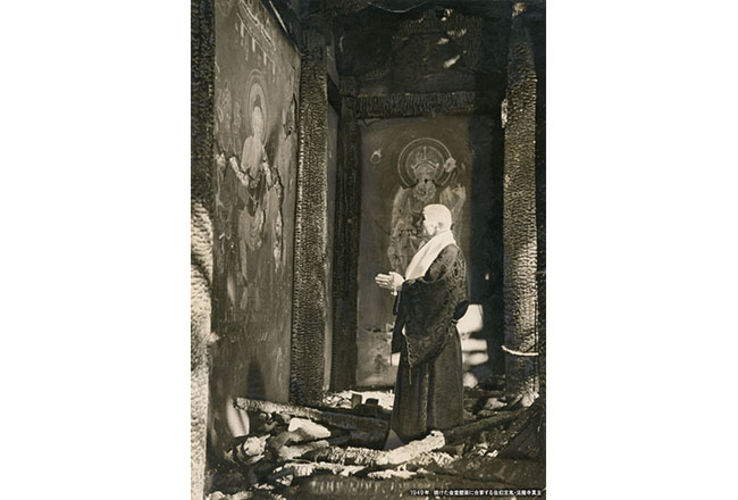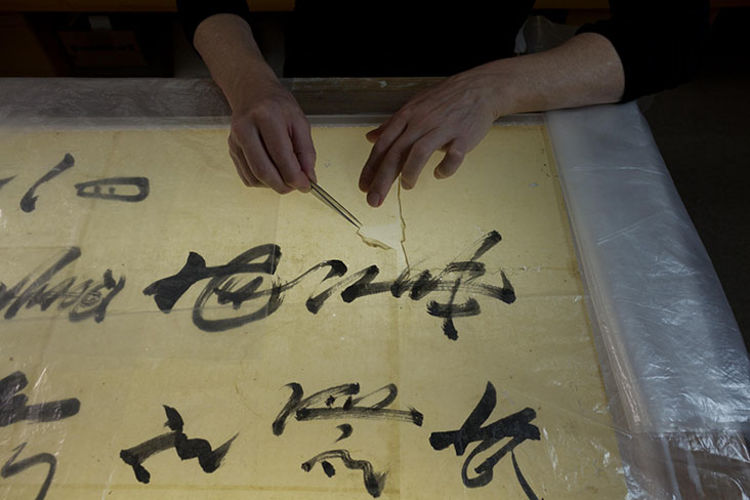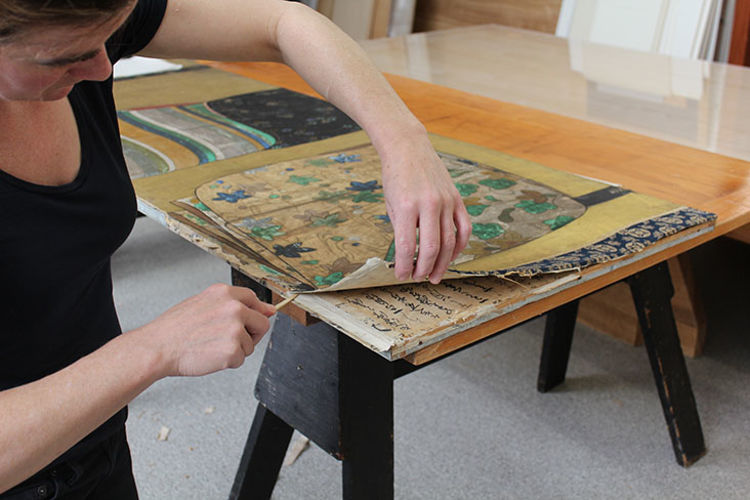Conservation Thinking in Japan brings together scholars from Japan and the United States to explore the history of conserving in Japan. Among the topics to be discussed are the role of replicas in a culture of conservation, the relationship between traditional materials and conservation practices, the conservation of wooden sculptures and Buddhist sculptures, the transition from antiquarianism to cultural heritage, the history of heritage legislation, and the relationship between conservation and museums. The afternoon presentations on paintings will constitute a symposium within the symposium, with presentations offering a microhistory of a single painting’s conservation history, a discussion of conservation of Buddhist paintings, and a roundtable discussion with paintings conservators focusing on the way the mounting of paintings—and the different ways conservators are trained to think about mounts—shapes the practice of conservation.
Conservation Thinking in Japan is the first of two days of symposia to focus on the robust and distinctive conservation traditions of Japan and India. When launching Cultures of Conservation in 2012 BGC hoped to foster a dialogue between the field of conservation and scholars of the human sciences and bridge the gulf generated by institutional divisions and the inevitable self-siloing of successful research agendas. The associated research project, “Conserving Active Matter,” then taught us that the ways in which we conceive of “conservation,” like the ways we think about “matter” and “activity,” reflect the shape of European and then Euro-American institutional and intellectual history. The working group on Indigenous ontologies of matter made us aware that the Euro-American model described but one set of possibilities. A recognition that the conservation worlds of India and Japan operate differently reinforced our discovery of the provincialness of Western conservation thinking, regardless of how globalized it has become. As Cultures of Conservation comes to an end, we launch exploratory probes into these different conservation worlds in the hope of reshaping an understanding of conservation as a human science.
Conservation Thinking in Japan and Conservation Thinking in India are being held in conjunction with the current exhibition, Conserving Active Matter (March 25–July 10). It is the concluding event in Cultures of Conservation, a ten-year initiative largely funded by The Andrew W. Mellon Foundation, and dedicated to modeling a cross-disciplinary conversation between conservators, conservation scientists, and humanists.

Funded by The Andrew W. Mellon Foundation.
Peter N. Miller (Bard Graduate Center)
Welcome and Introduction
9:10 am
Yukio Lippit (Harvard University)
“The Shōsōin Imperial Treasury and the Cultures of Conservation in Japan”
9:50 am
Coffee Break
10:10 am
Michihiko Mori (Kyoto National Museum)
“The Protection and Conservation of Cultural Heritage During the Edo (1615-1868) and Meiji (1868-1912) Eras: The Foundation of Japan’s Conservation of Cultural Properties”
10:50 am
Takeo Oku (Agency for Cultural Affairs)
“The History of the Conservation of Japanese Buddhist Sculpture”
11:30 am
Nobuyuki Kamba (Tokyo National Museum, Emeritus) and Melissa M. Rinne (Kyoto National Museum)
In Conversation
12:30pm
Lunch Break
2 pm
Noriko Hayakawa (Tokyo National Research Institute for Cultural Properties)
“The Relationship Between Traditional Painting Materials and Techniques in Japan from a Scientific Perspective”
2:40 pm
Ryusuke Masuki (University of Tokyo)
“The Conservation of Buddhist Painting in Japan’s Heian Period (794-1192)”
3:20 pm
Coffee Break
3:40 pm
Miriam Chusid (University of Washington)
“Buddhist Painting Repair as Soteriological Practice: The Case of the Taima mandara”
4:20 pm
Jennifer Perry (Metropolitan Museum of Art), Akiko Niwa (Freer Sackler Galleries, Smithsonian Institution), Keisuke Sugiyama (Tohoku University of Art and Design), and Tanya Uyeda (Museum of Fine Arts, Boston), chaired by Yukio Lippit (Harvard University)
Roundtable on Paintings Conservation
5:30 pm
Reception
Noriko Hayakawa is Head of the Restoration Materials Section at the Tokyo National Research Institute for Cultural Properties, where she has been employed since 1998. Hayakawa has published widely on the use of traditional organic materials in the conservation of art and is Editor-in-Chief of the Journal of the Japan Society for the Conservation of Cultural Property. Publications include “The Conservation of Wall Paintings of Tumuli in Japan” (2020) and “Analysis of an Ancient Adhesive, the So-Called Mamenori (Unfermented Soybean Paste)” (2014).
Nobuyuki Kamba is a conservator and author. Previously he served as head of the Conservation Department at the Tokyo National Museum (1998-2015), which he helped to establish. Kamba has also worked as a conservator at the Sokei School of Fine Art in Tokyo and Associate Professor at the National Museum of Japanese History. He has published widely on conservation matters. The English translation of one of his books, Conservation Practice in Museums: For Researchers and Museum Professionals, was published this spring.
Yukio Lippit is Professor of History of Art and Architecture at Harvard University. In 2018 he was appointed Harvard College Professor for a five-year term for distinguished contributions to undergraduate teaching. Recent publications include Sesson Shūkei: A Zen Monk-Painter in Medieval Japan (2021) and “Japanese Painting: Mounting, Mediation, Transmission, Renewal” (forthcoming from the Clark Art Institute, 2022).
Ryusuke Masuki is Associate Professor of Japanese Art at the University of Tokyo. Previously he wrokked at the Yamato Bunkakan Museum (1999-2004) and the Agency of Cultural Affairs (2004-2013) before teaching at Kobe University (2013-2021). He has published widely on early Japanese and East Asian Buddhist painting, including Insei-era Buddhist Painting and Tang-Song China (Insei-ki butsuga to TōSō kaiga, 2015), and Volume One of the series The Art History of the Imperial Court (Tennō no bijutsushi, 2018).
Michihiko Mori is curator of medieval Japanese painting at the Kyoto National Museum. He previously served as curator at The Museum of Kyoto (2012-2019). Mori’s primary research interests center around both painting of the 14th thru 16th centuries, and the mounting, archiving, preservation, and conservation of antiquities in Japan, including the “cultures of conservation.” Among his many publications, the most recent include National Treasures of the Capital (Miyako no kokuhō, 2021) and “The Preservation and Transmission of Screen and Wall Paintings during the Early Modern Period” (Kinsei ni okeru shōhekiga no hozon to keishō, 2020).
Akiko Niwa is a conservator of Japanese painting at the National Museum of Asian Art. She uniquely combines traditional training in Japanese painting conservation with a Ph.D. on the history of hanging scroll formats from Kyoto University of the Arts (2019). After seven years of training, Niwa received a certificate as Master Mounter and Conservator of Paintings and Calligraphy from the Kyoto Cooperative Association of Mounters and Conservators, and opened her own conservation studio in Kyoto. Niwa has also worked as a curator, and teaches an extension school course on mounting techniques at the Kyoto University of Art and Design.
Takeo Oku is Chief Investigator of Cultural Properties at the Agency for Cultural Affairs, where he has worked since 1991. Oku also serves on the Editorial Board of the art history journal Kokka. He has published widely on the history of Japanese and East Asian Buddhist sculpture and overseen numerous government-sponsored conservation projects of important works of art. Book-length publications include The Seiryōji Shaka Sculpture (Seiryōji Shaka nyorai zō, 2009) and The Creation and Reception of Buddhist Sculpture, Centering on the Heian Period (Bukkyō chōkoku no seisaku to juyō—Heian jidai o chūshin ni, 2019).
Jennifer Perry is the Mary and James Wallach Family Conservator of Japanese Art at The Metropolitan Museum of Art. She graduated in art history from Williams College (1986) and obtained an MA in art history and a diploma in conservation from the Institute of Fine Arts (1993). Perry trained in Japan at the Yamaguchi Bokunindō (1995-1997) and Oka Bokkōdō in Kyoto (1997-2003). During her tenure as Associate Conservator for Asian Paintings at the Cleveland Museum of Art (2004-2010), she established a program for the care and treatment of Asian paintings.
Melissa Rinne is Senior Specialist in the Department of Research and International Collaboration in the Curatorial Division of the Kyoto National Museum, as well as an ICOM-ICDAD board member and lecturer at Kyoto City University of Arts. Previously she served as Associate Curator of Japanese Art at the Asian Art Museum of San Francisco (2005–2013). Rinne is a specialist in the history of Japanese textiles, and recent publications include “Foreign Textile Collectors in Taishō Period Kyoto: A Guestbook from the Shop of Nomura Shōjirō” (2022) and “Jōfu: A Bast Fiber Textile Imitating Silk” (2020).
Keisuke Sugiyama is Associate Professor in the Department for Conservation of Cultural Property at the Tohoku University of Art and Design, as well as running the private conservation practice Shozuidō. He previously worked at the Usami Shōkakudō conservation studio (1997-2006) before serving as Senior Conservator of Japanese Paintings at the British Museum (2007-2015). He many publications in both English and Japanese include “Conservation of Japanese Paintings on Silk and Paper: Tradition and Innovation” (2014).
Tanya Uyeda is Conservator for Japanese Paintings at the Asian Conservation Studio of the Museum of Fine Arts, Boston, where she has worked since 2000. She earned a B.A.in East Asian Studies (Japanese language and history) from Oberlin College (1988), and an M.A. in Conservation of Cultural Properties from Tokyo University of the Arts (Tokyo Geijutsu Daigaku) (1997). Additional academic programs and fellowships include the Associated Kyoto Program at Doshisha University (1986) and University of Nagoya (Japanese literature) (1989-1991) and the Japan Foundation (2004). Her research interests include mounting styles for nikuhitsu ukiyo-e hanging scroll paintings, and opportunities for collaboration with Euro-American Textile and Paper conservation.
We have opened registration for a limited in-person audience. Bard Graduate Center requires proof of vaccination and photo identification to enter the building. Guests are required to wear masks regardless of vaccination status.
Zoom
This event will also be available on Zoom. A link will be circulated to registrants in advance of the conference. This event will be live with automatic captions.



